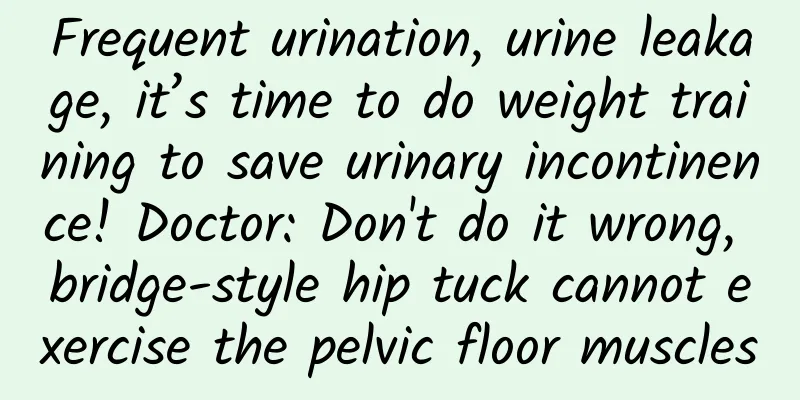Frequent urination, urine leakage, it’s time to do weight training to save urinary incontinence! Doctor: Don't do it wrong, bridge-style hip tuck cannot exercise the pelvic floor muscles

|
If women have problems with frequent urination or urine leakage, it is always dripping...even sanitary pads cannot cover it, and it may also emit a urine odor. It is really very troublesome. It may be urinary incontinence that is causing trouble! Obstetricians and gynecologists say that if you have urinary incontinence, you should do "weight training" for your pelvic floor muscles. However, some people on the Internet teach that in addition to Kegel exercises, doing the "bridge pose" is also a good choice for training the pelvic floor muscles. Is this true? Causes of urinary incontinence: increased abdominal pressure, lack of female hormones during menopause, and relaxation of the pelvic floor muscles Obstetrician and gynecologist Zeng Yuwen said that the main causes of urinary incontinence include increased abdominal pressure, lack of female hormones during menopause, and relaxation of the pelvic floor muscles. Obesity, long-term coughing, and constipation will all increase abdominal pressure; as for women after menopause, the lack of female hormones will cause collagen loss. And pelvic floor muscle relaxation is also one of the culprits of urinary incontinence. According to a survey conducted by the Institute of Public Health at Yang-Ming University, among the 4,661 women aged between 55 and 64, more than 30% suffered from urinary incontinence; and among the women aged between 35 and 44, 14.7% were even unable to dance due to urinary incontinence. Urinary incontinence has become an indelible shadow for women. Women in menopause are prone to frequent urination, urinary incontinence, and nocturia, which should also be taken seriously. However, according to statistics, less than 20% of women will take the initiative to seek medical treatment. Even many women who have symptoms such as frequent urination, urinary inconvenience, and nocturia feel embarrassed to see a doctor and find it difficult to bring up the matter. Or they wishfully believe that even if they see a doctor, they may not get better. Therefore, they would rather endure the inconvenience in life and keep putting it off. In particular, the issue of women's menopause must also be taken seriously. According to the National Development Council's estimates, by 2030 the median age of Taiwan's female population will be 50, and the degree of aging is obvious. If the average age of women entering menopause is between 48 and 50, it is estimated that about half of women will enter menopause by then. Relatively speaking, the problem of urinary incontinence will also follow. If you have urinary incontinence, in addition to treatment, it is recommended to exercise the pelvic floor muscles In fact, if you have urinary incontinence problems, in addition to seeking treatment, you can also help relieve the problem by exercising your pelvic floor muscles. Obstetrician and gynecologist Zeng Yuwen said that the human body's pelvic cavity contains organs such as the uterus, ovaries, bladder, and rectum, which are supported and fixed by the pelvic bones, pelvic floor muscles, and ligaments and fascia. After the age of 30, the pelvic floor muscles lose an average of 3% to 5% each year. Especially after the age of 50, the problem of frequent urination becomes more serious. Therefore, exercising the pelvic floor muscles early can delay the subsequent diseases. There are three main categories of diseases caused by the pelvic floor muscles, including urinary incontinence, fecal incontinence, and pelvic organ prolapse (for example: bladder prolapse, uterine prolapse, rectal prolapse). Kegel exercises can help reduce postpartum urinary incontinence, prevent uterine prolapse, and improve vaginal relaxation When it comes to exercising the pelvic floor muscles, most people know that they need to do Kegel exercises, which can also be called pelvic floor exercises. Kegel exercises were invented by an American obstetrician and gynecologist, Dr. Kegel, in 1948. The original purpose was to reduce postpartum urinary incontinence, prevent uterine prolapse, and improve vaginal relaxation. There are two ways to do Kegel exercises: 1. Toilet holding urine method: When you are going to the toilet and suddenly stop holding your urine, it is the force exerted by the pelvic floor muscles. Then try to slowly relax those muscles and continue to urinate. You will be able to feel the pelvic floor muscles during this process. Each contraction should be maintained for 5-10 seconds, and then relaxed for 5-10 seconds. It is recommended to practice for more than 10 minutes every day. However, you don't need to hold your urine every time you go to the toilet. Just remember the feeling of holding your urine. 2. Advanced version of "finger training method": After washing your hands, insert your fingers into the vagina and apply force. When your fingers feel being clamped by the vaginal muscles, it means that the pelvic floor muscles are applying force correctly. If you have no sexual experience, you can insert your fingers into your anus. The principle is the same. By feeling the tightening pressure of the vagina or anus with your fingers, you can tell whether your practice has made progress and whether the tightening intensity is getting stronger. Kegel exercises can be performed while sitting or standing. It is recommended that you consult a specialist before doing them to avoid incorrect movements. The bridge exercise can only strengthen the gluteal muscles, leg muscles, and trunk core muscles, and is not a special exercise for training the pelvic floor muscles. Dr. Zeng Yuwen specifically reminded that some women like to go to the gym, and fitness coaches will instruct them to do "bridge" exercises, thinking that they are Kegel exercises that can prevent urinary incontinence. In fact, the bridge exercise is not an exercise specifically for training the pelvic floor muscles. The way to do the bridge exercise is: put your feet as wide as your knees and hips, squeeze your buttocks and use your abdomen, and do chest breathing (diaphragm breathing). It can only strengthen the buttocks muscles, posterior thigh muscles, and core muscles, but cannot train the muscles in this area of the pelvic floor muscles. In addition, there are many new options for the treatment of urinary incontinence, such as the electromagnetic chair (commonly known as the G-motion chair) with high-intensity focused electromagnetic technology. It stimulates the pelvic floor nerves through electromagnetic waves, causing the pelvic floor muscles to produce more than 10,000 super-limit contractions. It is gradually being widely used in the treatment of urinary incontinence. High-performance pelvic exercises help strengthen the pelvic muscles, providing a new option for postpartum women who have trouble with urinary incontinence. |
Recommend
How to treat menopausal adenomyosis
How to treat menopausal adenomyosis? We know that...
One deep and one shallow is a sign of menstruation
Is the phenomenon of one dark and one shallow a s...
How to regulate irregular menstruation? There are two common methods of regulating irregular menstruation.
After irregular menstruation occurs, you must pay...
Can uterine fibroids be cured? What are uterine fibroids?
Can uterine fibroids be cured? What are uterine f...
What to eat to reduce swelling of cervical hypertrophy
Cervical hypertrophy cannot be reduced by diet, s...
Is it harmful to play with your phone after a miscarriage? Do these 4 things
For female friends, miscarriage will not only bri...
The shape and size of the uterus
The normal uterus is shaped like an inverted pear...
Eat 4 kinds of food to help reduce edema
When taking photos with friends, you are always a...
Patients with adnexitis should take good care of themselves
Women should know about gynecological diseases su...
What are the consequences of eating crabs after abortion?
Eating crabs after an abortion may cause diarrhea...
Introduction to the hazards of endometrial tuberculosis
Some women think that the endometrium will shed e...
The preventive measures for pelvic inflammatory disease should be taken seriously
In life, many people do not fully understand the ...
Diagnosis details of postmenopausal bleeding
Generally, women who have stopped menstruating fo...
Human factors may also cause cervicitis
Although cervicitis is a common gynecological dis...
How to distinguish the size of the left ovarian cyst and how to treat it effectively
Left ovarian cyst is a common benign tumor of the...









